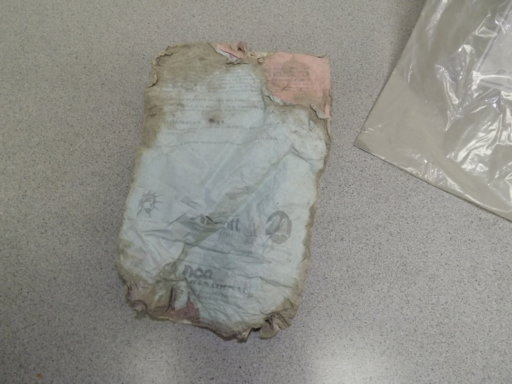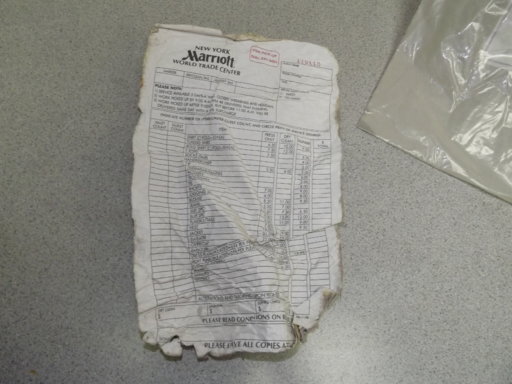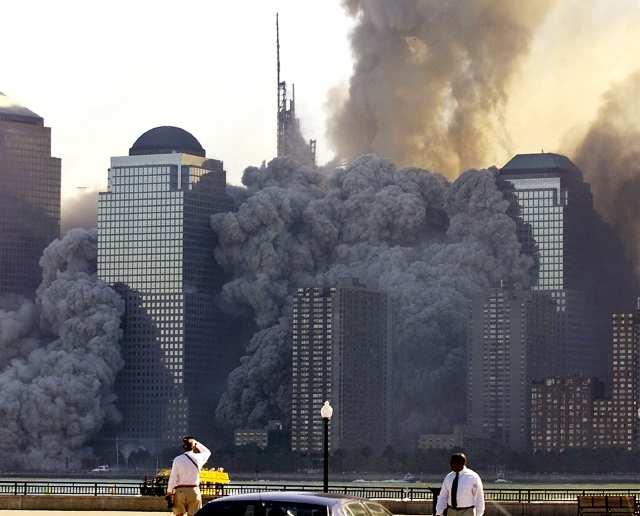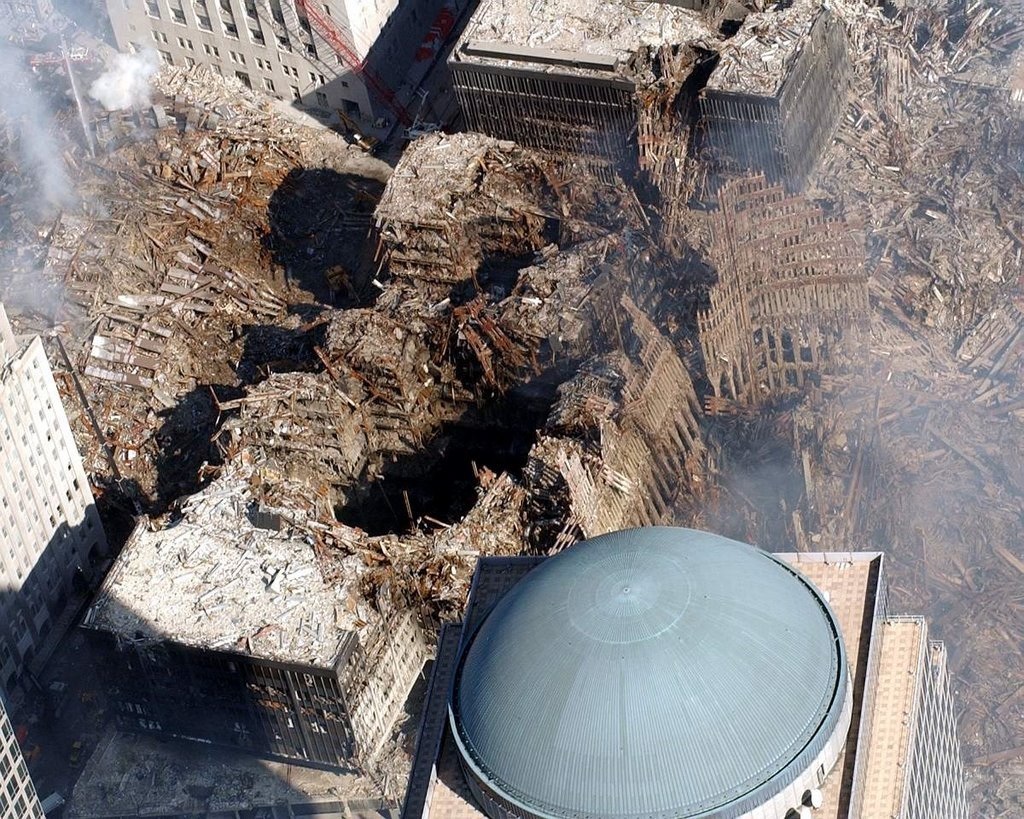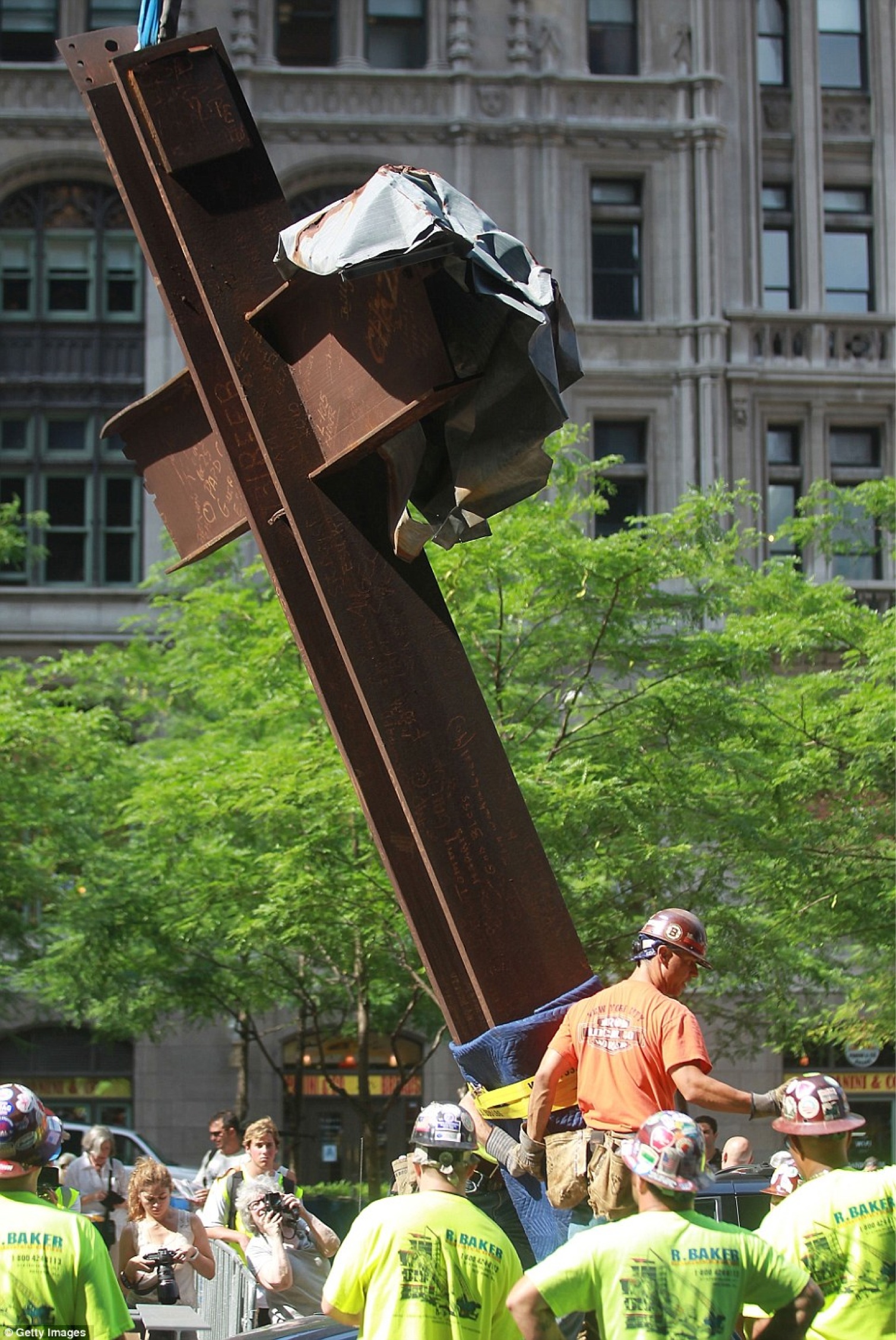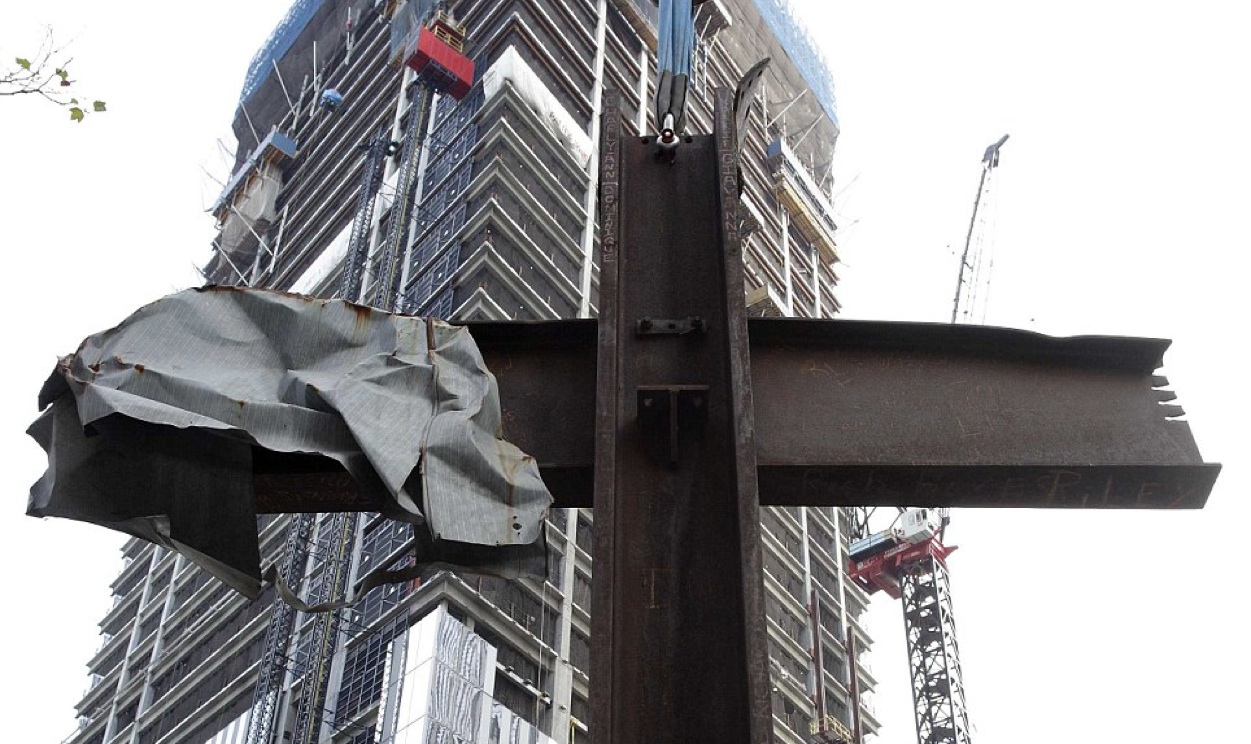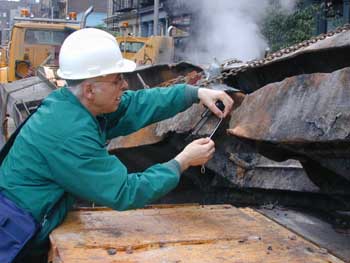Mike said:
Not really, it was (mostly) concentrated into a volume about five acres in area, and 120 feet high, over a second or so. That's very different to a single instantaneous impact at a point or a plane. From a physics point of view it was a lot of individual events in both space and time. To describe it as a single event, and perform calculations thusly, is an over simplification that just gives the bounds of the problem, not the reality.
Well, that's wrong, isn't it?
Most of the energy ended up in the steel. Neither air nor concrete had a hope of extracting a
majority of the energy involved.
The core columns punched the basement foundations every time they reacted to punching off the next floor in an aggregating mass of floors. That would have been 50+ times.
The forces were at their strongest the deepest down in the maelstrom of the core column basement foundations. The column bases would have been upset. That's a technical term. Their girth would have increased as they shortened. A significant proportion of the original potential energy would have been concentrated right at the foundations in the steel pressing down against them by virtue of the design of the building.
"Hot spots" were inevitable because they were the reaction points against which each floor was being sheared off during the collapse.
Grieves said:
So this is the only aspect of that calculation you present which even begins to take time into account, being representative of the pull of gravity, and the rate of acceleration of objects under it's influence.
The inclusion of time is necessary to make the summation of the energy in the statement PE = 0.5*Mgh. "It's" means "it is".
However: (quotes an irrelevance). So because there's no room in your 'simple, indisputable' calculation for anything but free-fall speeds under the wholly unresisted force of gravity, nor is there room for the influence of the atmosphere and obstructing objects, your calculation is inherently flawed, is it not? Especially considering the anti-'truthers' have tried to make it terribly clear the towers did not reach free-fall speeds, which are the conditions your calculation applies too, if any.
The atmosphere does very little to obstruct the passage of descending steel. "Obstructing objects" are part of the above equation. The towers fell at 2/3 free fall, but that isn't material, except to say that a portion of that retardation was taken up by heating the reacting column bases.
It is your understanding of the nature and purpose of calculations in physics that is at fault.
The official account demands that the descent of most of the steel mass was repeatedly obstructed.
Not in the report I read.
lee h oswald said:
Am I right in reading that you think/believe that the vast majority of the energy created by the collapses of the towers went to heating the steel to near its melting point of 1500C or thereabouts?
No.
And then it stayed that way for weeks? By what mechanism?
The way your fridge works.
Also, you stated that crushing concrete doesn't require much energy
Just give me a sledgehammer and I'll show you.
but just how much energy does it take to pulverise 440.000 sq metres of steel RC (per tower) 100-125mm thick with a compressive strength of 3-3500 psi and set in corrugated steel decking? And after reducing said concrete to very small bits, in the main, distribute it over a wide area in the form of a - hot - pyroclastic dust cloud? What about all that energy? You haven't mentioned it.
Yes I have. I have already said it was an insignificant part. The WHOLE of the energy was equivalent to this:
me said:
Have a look at any destroyed battle tank. How did that come about? Magic?
Magic? No. Explosives.
Sometimes a solid round does the job, so explosives? No. Kinetic energy.
me said:
The columns were candidates for a lot of friction welding (and sparks) as dozens of floors sheared by them.
Friction welding in a few seconds of chaos? I don't think so. Sparks would be normal, but sparks don't weld anything. It's quite hard to light a fire with a spark - even when you've got the best of conditions set for it.
Wedding would take place AFTER things were stopped. Prior to that there would be flow. Hot iron moving in friction against itself will produce sparks.
And when you say 'all slagged up' do you mean by that the core is covered with slag from previously molten metal?
It has just had a hundred floors slide by it in an unfriendly manner. That will have melted stuff.
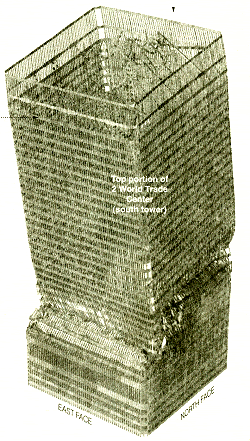
Putting it politely, I think the buckling instability is inherent in your absurd hypothesis.
You shouldn't make claims beyond your means. I am glad the phrase "buckling instability" stuck in your mind. You should grasp the straw and test the proposition.
MikeC said:
it checks out with the exception that the height of the twin towers was 409 and 411 metres (according to wiki), so he has underestimated the value by about 2.5%.
I didn't include the radio masts.
What do you think happened to all that energy?
Yes indeed. Where DID it go? Grieves? Lee?
Grieves said:
The math is based on a false premise, though... that the towers, and all its separate segments, were in free-fall all the way down
No. It isn't, and you are wrong. It is based on the
energy available for release if a collapse occurs.
There was undoubtedly a whole lot of kinetic energy involved in the collapse, and assuredly it produced a fair deal of heat, but there was ample opportunities for dissipation throughout.
Well, no. The kinetic energy was
one and the same as the potential energy, and there were places where that energy
couldn't so easily dissipate.
Friction welding techniques are generally melt-free, which avoids grain growth in engineered materials, such as high-strength heat-treated steels.
That isn't true at all. Grain growth typically occurs in solid solution in solid metal at temperatures
much lower than melt.
I don't think an industrial process involving speeds as high as 2000+ rpm concentrated to produce a deliberate effect is a fair example of what might have happened in the collapse.
Let's see, shall we? 2000 rpm is 33.3 turns per second, and a six-inch diameter pipe surface would therefore be traveling at 52.4 feet per second. The 50,000 ton floor sandwich reached 200 feet per second.
You are correct. It doesn't even begin to provide a fair example. A
sixteenth of a fair example would be closer to the truth. Oxymoron take note...
In any event, given that there's seemingly enough evidence of molten steel to have Jazzy and Mike arguing for its presence being an obvious result, can someone tell me what the hell John Gross was talking about?
You misrepresent what has occurred. There has never been any evidence of molten steel. Talking about "evidence of molten steel" isn't
actually evidence of molten steel, you know.
Mike said:
Let's take the amount of energy as correct, as it gives a useful upper bound.
Amen.
It's not really important, as the amount of molten steel we are talking about is very small
You […wrong]. We aren't talking about molten steel at all, just "hotspots".
There were NO fires in the rubble capable of melting the steel at all. Not even steel already raised to melt temperature.
the heat in the pile is thought to have come from fires, and there were plenty of sources of ignition.
You cannot melt steel at 1535 deg C with an 1100 deg C flame.
The question is if there's a realistic mechanism whereby the energy could be concentrated in a volume of steel
Yes, and I have already described it.
It seems pretty obvious that if you drop an individual girder from 1000 feet onto concrete, then it's not going to melt, it's probably not even going to get particularly warm. There has to be a particular mechanism, sudden bending or prolonged friction or extreme impact pressure with additional weight, to make this happen.
It may seem "obvious" but the plain fact is that it
still has the
same amount of potential energy that it ever had, and when it came to rest the majority of its potential energy would reside as
hotter steel. It will be severely distorted somewhere, and that place would be extremely hot - for a moment. The girder would then equilibrate to some warmer temperature.
The distinction you have to make is that the columns (particularly the inner ones) had a
continual hand in arresting that downward motion
of everything else which
concentrated energy at their bases. Instead of being "mildly warmed" they were dealing with severe impact loads from many sources. Energy, in the loosest sense, was being
channeled to the foundations via the columns.
It's all interesting from a thought experiment though, but I don't think it really has much bearing on the plausibility of the conspiracy theory, or the validity of the OS.
You could be right there. For want of the necessary.
Oxymoron said:
I keep trying to have sensible and constructive dialogue, I have offered out many an olive branch and had abuse in response... so yes, let's by all means have a constructive and polite discussion.
I know it's hard. I'll try my best to help you out.

Perhaps we can start with an instance or two where kinetic energy has produced molten steel in a collapse. Followed by a documented instance or two where Jazzy's equation has used to account for the production of said volume of molten steel. And finally perhaps some instances of experiments conducted which predict the production of a set quantity of molten steel from a collapse; followed by the actual quantity of molten steel produced by each experiment.
Why? I don't believe there was any molten steel to be seen. Maybe molten
metal. There were tons of cast zinc and cast aluminum furnishings, of course, and eighty tons of plane in a bonfire.
Try and understand that there were hundreds of tons of lower-melting-temperature alloys in the towers.
I would humbly suggest that the majority of that energy went into pulverizing the constituent parts of the building.
And you'd be wrong. There is very little energy in a twenty-second roar of noise and 50 million cubic feet of hot air. Not compared with 95 tons of TNT. Steel cannot actually be pulverized at ambient temperature. It needs to be deeply frozen for that to happen. The energy resides in the steel. It's where the
mass is.
Unsurprisingly reinforced concrete does actually take considerable energy to be converted into dust.
The steel portion of it was never converted into dust. The concrete is brittle and converts to dust easily once it fails.
Grieves said:
Fair, not every single testimony can be considered accurate. It's still evidence though, one way or another
It isn't evidence at all if it isn't evidence.
Plus the photos, plus Astaneh-Asl's unpublished findings. Many of these claims of molten steel were sourced in news agencies NIST itself used for evidence, and his interview was years after the event/most of the NIST report, so what in the hell is he talking about? How could he, a lead engineer of NIST, the organization that's supposed to be thoroughly investigating the events, have not even heard that there might have been molten steel present? That's either indicative of a lie or that NIST bungled the investigation even more spectacularly than previously imagined. His narrow stare and his thin-drawn smile when the topic comes up doesn't do him any favors either.
This does you none at all. Either.
Keep on stretching.

